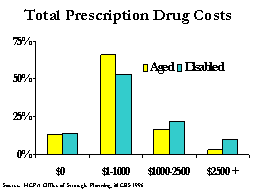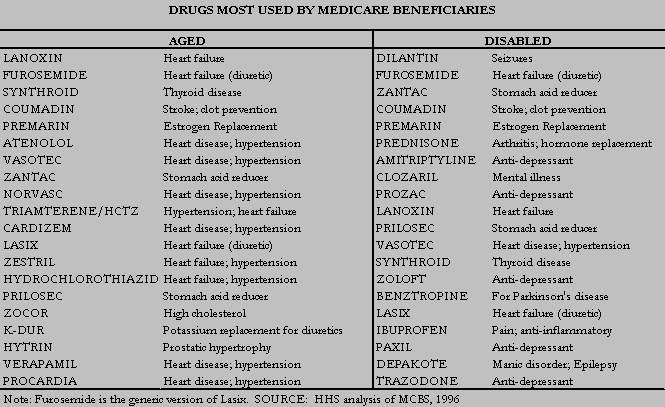
|
 |
| |
DISABILITY, MEDICARE, AND PRESCRIPTION DRUGS
Medicare Beneficiaries as Percent of State Residents
The White House National Economic Council / Domestic Policy Council July 31, 2000 EXECUTIVE SUMMARY: DISABILITY, MEDICARE, AND PRESCRIPTION DRUGS Medicare currently provides critical health care for about 5 million Americans with disabilities. However, one of the most important health benefits for people with disabilities – prescription drugs – is not covered by Medicare. Lack of coverage for medications can have grave health consequences for people with chronic conditions and diseases. It also limits their ability to live independently and return to work since drugs have become essential to improving functioning. For example, a person with muscular dystrophy, Parkinson's Disease, or diabetes may be able to function and return to work with appropriate prescription drugs, but may not be able to afford them without insurance. Medicare's lack of drug coverage will become even a greater barrier as we inevitably discover breakthrough drugs. This report documents the unique need of disabled Medicare beneficiaries for prescription drugs, provides state-by-state information on these beneficiaries, illustrates how the private insurance market has not been responsive to their needs, and validates the importance of a voluntary, affordable, and meaningful Medicare prescription drug benefit. MEDICARE IS ESSENTIAL FOR PEOPLE WITH DISABILITIES
MEDICARE BENEFICIARIES WITH DISABILITIES NEED MORE AND DIFFERENT TYPES OF PRESCRIPTIONS
MEDICARE BENEFICIARIES WITH DISABILITIES FACE DIFFERENT COVERAGE CHALLENGES THAN ELDERLY BENEFICIARIES
ACCESS TO DRUGS FOR UNINSURED DISABLED BENEFICIARIES IS LIMITED
IMPLICATIONS OF THESE FINDINGS FOR A PRESCRIPTION DRUG PLAN As this report shows, Medicare beneficiaries with disabilities have a strong need for prescription drug coverage. It underscores that, to ensure that people with disabilities have access to a meaningful, affordable prescription drug benefit, the policy must:
DISABILITY, MEDICARE, AND PRESCRIPTION DRUGS Medicare is an essential source of health coverage for over 5 million people with disabilities. Beginning in 1973, Medicare extended its coverage to people with disabilities who have received Social Security Disability Insurance (SSDI) for at least two years. Medicare Part A is also available to about 300,000 people with end-stage renal disease (ESRD) (permanent kidney disease treated through dialysis or a kidney transplant). MEDICARE IS ESSENTIAL FOR PEOPLE WITH DISABILITIES
More likely to have lower incomes. Over three-fourths of beneficiaries with disabilities have income below 200 percent of the poverty level (about $17,000 for a single person), compared to half of elderly beneficiaries. This is because, by definition, people receiving disability insurance usually cannot work due to their condition. Disproportionately live in rural areas. About 29 percent of disabled Medicare beneficiaries live in rural areas compared to nearly 25 percent of the general Medicare population. Beneficiaries with disabilities reflect population distribution of the nation as a whole. Reflecting the general population distribution across states, fully half of all beneficiaries with disabilities live in 10 states (in descending order): California, New York, Florida, Texas, Pennsylvania, Ohio, Michigan, Illinois, North Carolina, and Georgia. There are slightly more beneficiaries with disabilities as a percent of the state population in the eastern U.S.
The number of beneficiaries with disabilities is growing rapidly. The projected growth in the number of Medicare beneficiaries with disabilities will be rapid. Over the next ten years, the number of beneficiaries with disabilities is projected to increase by 38 percent (from 5.5 to 7.6 million) compared to an increase of 13 percent for the elderly (from 34.4 to 40.0 million). Account for 14 percent of Medicare spending. Medicare beneficiaries with disabilities have slightly higher average Medicare costs than do aged beneficiaries. This is mostly driven by the high costs of ESRD patients; whose average cost is $25,000. MEDICARE BENEFICIARIES WITH DISABILITIES NEED MORE AND DIFFERENT TYPES OF PRESCRIPTION DRUGS By definition, non-elderly, disabled Medicare beneficiaries have conditions that limit their ability to work. The most common types of disabilities are physical impairments or limitations, such as blindness or paralysis. Additionally, large and growing numbers of Medicare beneficiaries have some type of severe mental or emotional condition that interferes with daily activities. Medicare beneficiaries with disabilities have poor health and significant health care needs. On virtually all measures of health, Medicare beneficiaries with disabilities have worse health:
Medicare beneficiaries with disabilities tend to use more and different types of prescription drugs. Compared to the averages for all Medicare beneficiaries, those with disabilities tend to have conditions that require a greater number of, and more expensive, medications. 

Take different types of drugs. In an analysis of the most commonly used drugs, elderly beneficiaries were more likely to use medications cardiovascular disease (14 of the top 20), while disabled beneficiaries were more likely to use prescriptions for neurological disease or mental illness (9 of the top 20). The drugs used by beneficiaries with disabilities tend to have higher prices. MEDICARE BENEFICIARIES WITH DISABILITIES FACE DIFFERENT COVERAGE CHALLENGES THAN ELDERLY BENEFICIARIES
Medicare beneficiaries with disabilities are more likely to qualify for Medicaid which covers prescription drugs. As a result, Medicare beneficiaries with disabilities are slightly less likely to lack drug coverage (28 percent versus 32 percent of elderly Medicare beneficiaries are uninsured throughout the year). However, among those with prescription drug coverage, the proportion of disabled Medicare beneficiaries getting that coverage through private plans is half that of the elderly (35 percent versus 67 percent). This results because of the difficulty that people with disabilities have in accessing private health insurance. 35 percent less likely to have employer-based coverage. Employer-based insurance, along with Medicaid, is the most stable and comprehensive source of prescription drug coverage. However, while some elderly get coverage through retiree health plans, non-elderly disabled Medicare beneficiaries are not retirees and have typically lost access to employer-based insurance long before qualifying for Medicare. Only 22 percent of Medicare beneficiaries with disabilities have employer-based insurance that includes prescription drugs, compared to 34 percent of elderly beneficiaries.
Private Medigap insurance with drugs is often inaccessible and unaffordable. One private-sector alternative to employer-based coverage is individual insurance, which, for Medicare beneficiaries is known as Medigap. Three of the 10 standardized Medigap plans offer prescription drug coverage. However, less than 20 Medicare beneficiaries with disabilities have drug coverage through private Medigap insurance (versus 12 percent of elderly beneficiaries). A recent study found that only 10 states guarantee people with disabilities access to a Medigap plan with prescription drugs. Only 7 of those states have full or partial community rating that improves the affordability of this coverage. Without protections, premiums range from 10 to 72 percent higher for Medicare beneficiaries with disabilities than those who are elderly. Unlikely to get prescription drug insurance through Medicare managed care. While about 12 percent of Medicare beneficiaries are disabled, only 5 percent of Medicare managed care enrollees are beneficiaries with disabilities. In contrast, in 1996, 16 percent of elderly beneficiaries got drug coverage through managed care. In part, this results from the "cherry picking" or marketing to healthier beneficiaries that occurs within managed care. Restrictions on access to specialists that exist in many managed care plans also discourage enrollment by beneficiaries with disabilities. ACCESS TO DRUGS FOR UNINSURED DISABLED BENEFICIARIES IS LIMITED Recent studies have shown that all Medicare beneficiaries who lack dependable prescription drug coverage have trouble accessing needed prescription drugs. A study by the Department of Health and Human Services found that Medicare seniors and people with disabilities without drug coverage are five times more likely to report being unable to purchase prescriptions as those with coverage. Another found that elderly with chronic illness spent 50 to 200 percent more on prescription drugs than other elderly. A third study found that Medicare beneficiaries without coverage were 40 percent more likely than covered beneficiaries to fail to purchase needed antihypertentive medication, and took fewer tables when they did by it. And the nature of the coverage matters. Beneficiaries with coverage for only part of the year appear to have access problems similar to those without any coverage. Nearly half of all Medicare beneficiaries lack prescription drug coverage for part or all of the year.
Medicare beneficiaries with disabilities who lack prescription drug coverage pay out-of-pocket 50 percent more for 50 percent fewer prescriptions. Disabled beneficiaries without coverage must pay for all of their costs for prescription drugs compared to those with coverage who pay less out-of-pocket ($474 versus $312 per year). Although they pay more, uncovered Medicare beneficiaries get less. Medicare's disabled beneficiaries without coverage take on average only 16 prescriptions per year compared to 32 prescriptions for those with prescription drug coverage. Total drug spending on disabled beneficiaries without coverage is about 60 percent below that of those with prescription drug coverage ($474 versus $1,226). Gap is large among the most ill, Medicare beneficiaries with disabilities. Some have argued that we only need to provide prescription drug coverage for low-income Medicare beneficiaries, because middle-class beneficiaries with health problems find a way to get coverage. However, not only are there a significant number of uninsured among beneficiaries with disabilities in poor health, but those beneficiaries face especially troubling access problems. Beneficiaries with three or more chronic illnesses who lack coverage pay 76 percent more out of-pocket for prescription drugs ($680 versus $385) but fill 43 percent fewer prescriptions (23 versus 41) than those with drug coverage. Middle-class Medicare beneficiaries with disabilities are affected by lack of coverage as well. Some Congressional proposals would limit prescription drug coverage to Medicare beneficiaries with income below 150 percent of poverty. However, this would perpetuate the access problems that hundreds of thousands of middle-class people with disabilities currently experience. Beneficiaries with disabilities with income above this level pay about 70 percent more out-of-pocket but fill 30 percent fewer prescriptions. IMPLICATIONS OF THESE FINDINGS FOR A PRESCRIPTION DRUG PLAN As this report shows, Medicare beneficiaries with disabilities have a strong need for prescription drug coverage. It underscores that, to ensure access for people with disabilities, a drug benefit must: Ensure a Medicare option rather than rely on private insurers that have failed to extend prescription drug coverage to people with disabilities. Only a small number of beneficiaries with disabilities have access to drug coverage through private insurers, and when they do, it is often unaffordable. This is because it is against the financial interest of any insurer that bears the risk of high costs of drugs to enroll people with disabilities. As such, proposals that rely on voluntary participation of private plans, even with insurance reforms, would pose a special risk to Medicare beneficiaries with disabilities. Medicare beneficiaries with disabilities should have access to a Medicare-based prescription drug option that does not rely on private plan participation and does not force them into managed care. Be affordable and meaningful. Medicare beneficiaries with disabilities are disadvantaged by having both a greater need for prescription drug coverage and lower income than most elderly beneficiaries. Thus, any proposal for prescription drugs should have
Be adequately financed and part of a plan to improve Medicare. For beneficiaries with disabilities as well as the elderly, keeping Medicare strong is the best way to assure that it will be there when future retirees and people with disabilities need it. This does not mean imposing excessive new cost sharing or higher Medicare premiums. Instead, any reform plan should make Medicare more competitive and efficient, improve access to preventive services, and increase provider payments to guarantee access to high-quality care. Additionally, protecting the Medicare surplus by taking it off-budget has the effect of reducing the national debt and, consequently, the government's interest payments. This foregone debt service, when dedicated to the Medicare trust fund, helps extend the life of the trust fund to 2030 under the President's plan. Finally, in a time of unprecedented budget surpluses, there is no excuse to not dedicate sufficient budget surplus to Medicare to establish a meaningful prescription drug benefit. Note: Does not include Puerto Rico and territories
President and First Lady | Vice President and Mrs. Gore |